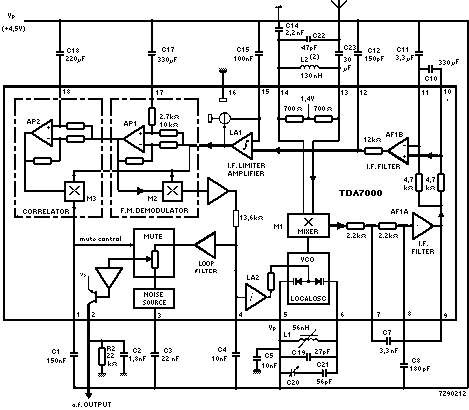A Complete FM Radio on a Chip AN192
AN192
Page 1 of 11
Signetics
This is a very useful and simple Signetics single chip FM receiver Integrated circuit product I've ever found I got this late 1985 in Akhihabara Electronic Market Tokyo. I was very glad when I got this IC though; the prize at that time was rather expensive. Why? The answer is because I got a little headache with designing a Satellite television receiver which needed a SCPC receiver for the Thai's TV sound channel . Adding a SPC Receiver means building a second TVRO so in utilizing this IC my job became much simple and easier. The C band 4 GHz down converter produced an If of 950 - 1.450 MHz that I routed through a second converter producing a baseband I.F. of 70 MHz. I feed this 70mHz-baseband signal to TDA7000 FM receiver. And hereby we can get a SCPC FM sound if the second converter is tuned to the correct Transponder
In these pages I copied the TDA7000 Sgnetics Application note for Your Perusal.
|
Lf., distortion would occur with the ±75 kHz i.f. swing due to received signals with maximum modulation. The maximum Lf. swing is therefore compressed to ±15kHz by controlling the local-oscillator in a frequency locked loop (FLL). The combined action of the muting circuit and the FLL also suppresses image response.
The new circuit is the TDA7000 which integrates a mono f.m. radio all the way from the aerial input to the audio output. External to the IC are only one tunable LC circuit for the local-oscillator, a few inexpensive ceramic plate capacitors and one resistor. The TDA7000 dramatically reduces assembly and post-production alignment costs because only the oscillator circuit needs adjustment during manufacture to set the limits of the tuned frequency band. The complete fm. radio can be made small enough to fit
inside a calculator, cigarette lighter, key-ring fob or even a slim watch. The TDA7000 can also be used as a receiver in equipment such as cordless telephones, CB radios, radiocontrolled models, paging systems, the sound channel of a tv set or other f.m. demodulating systems.
Using the TDA7000 results in significant improvements for all classes of f.m. radio. For simpler portables, the small size, lack of i.f. coils, easy assembly and low power consumption are not the only attractive features. The unique correlation muting system and the FLL make it very easy to tune, even when using a tiny tuning knob. For higherperformance portables and clock radios, variable-capacitance diode tuning and station presetting facilities are often required. These are easily provided with the TDA7000 because there are no variable tuned circuits in the r.f. signal

F19.1 The TDA7000 as a variable capacitor tuned fm. broadcast receiver
September 1985
LI = Toko MCIO8 No.514 HNE 150013SI3.
C2 = Toko No. 2A -15BT-Ft0I